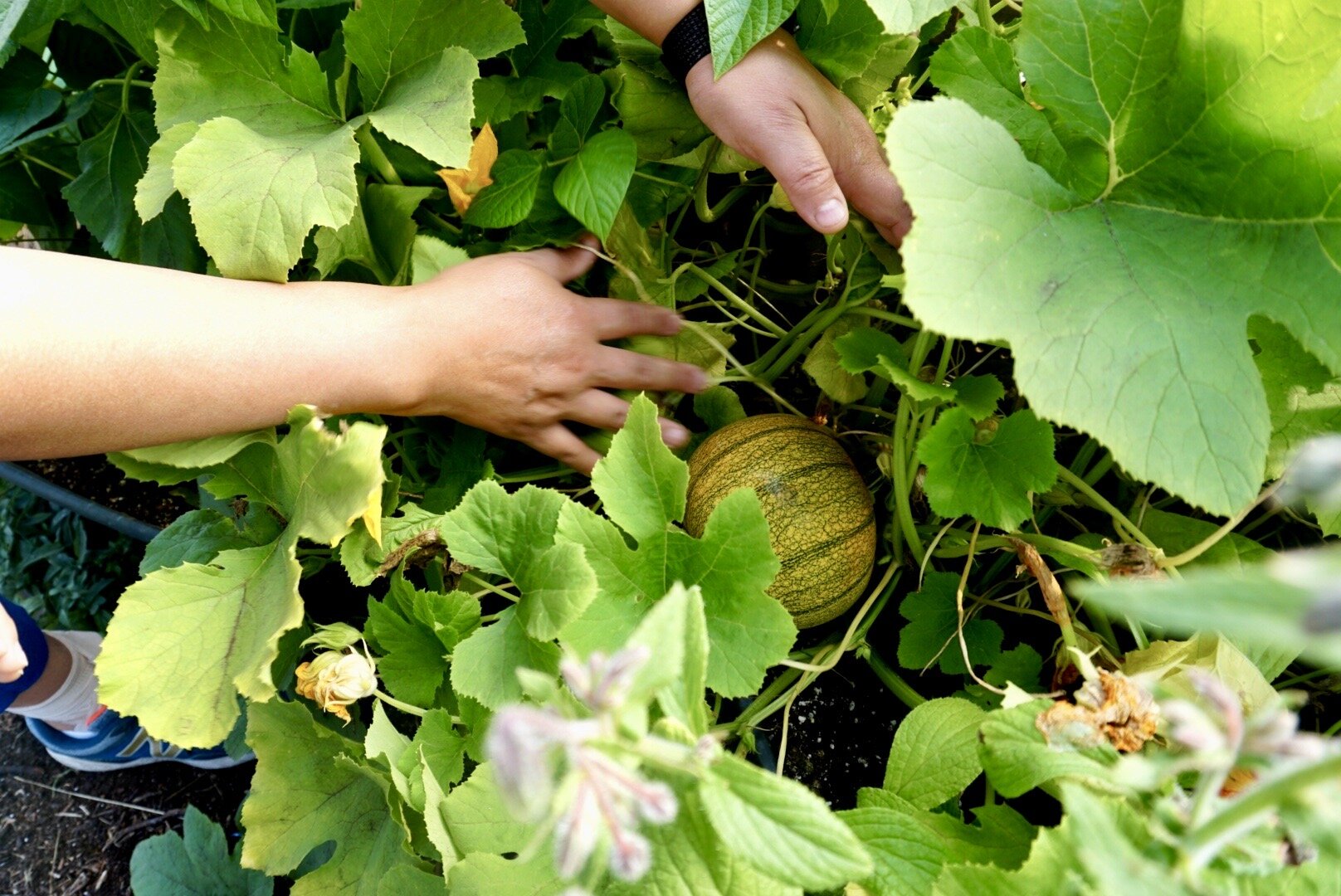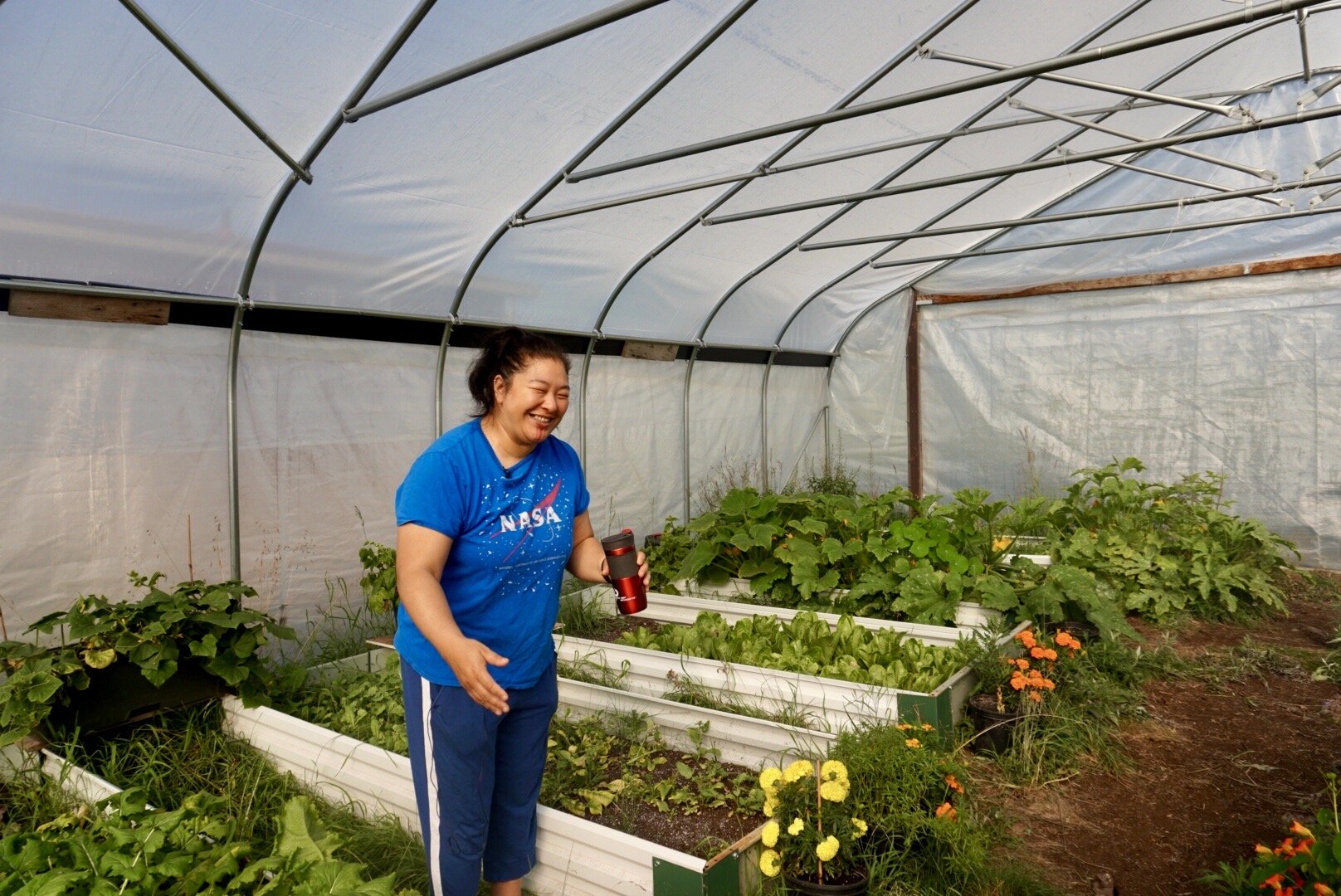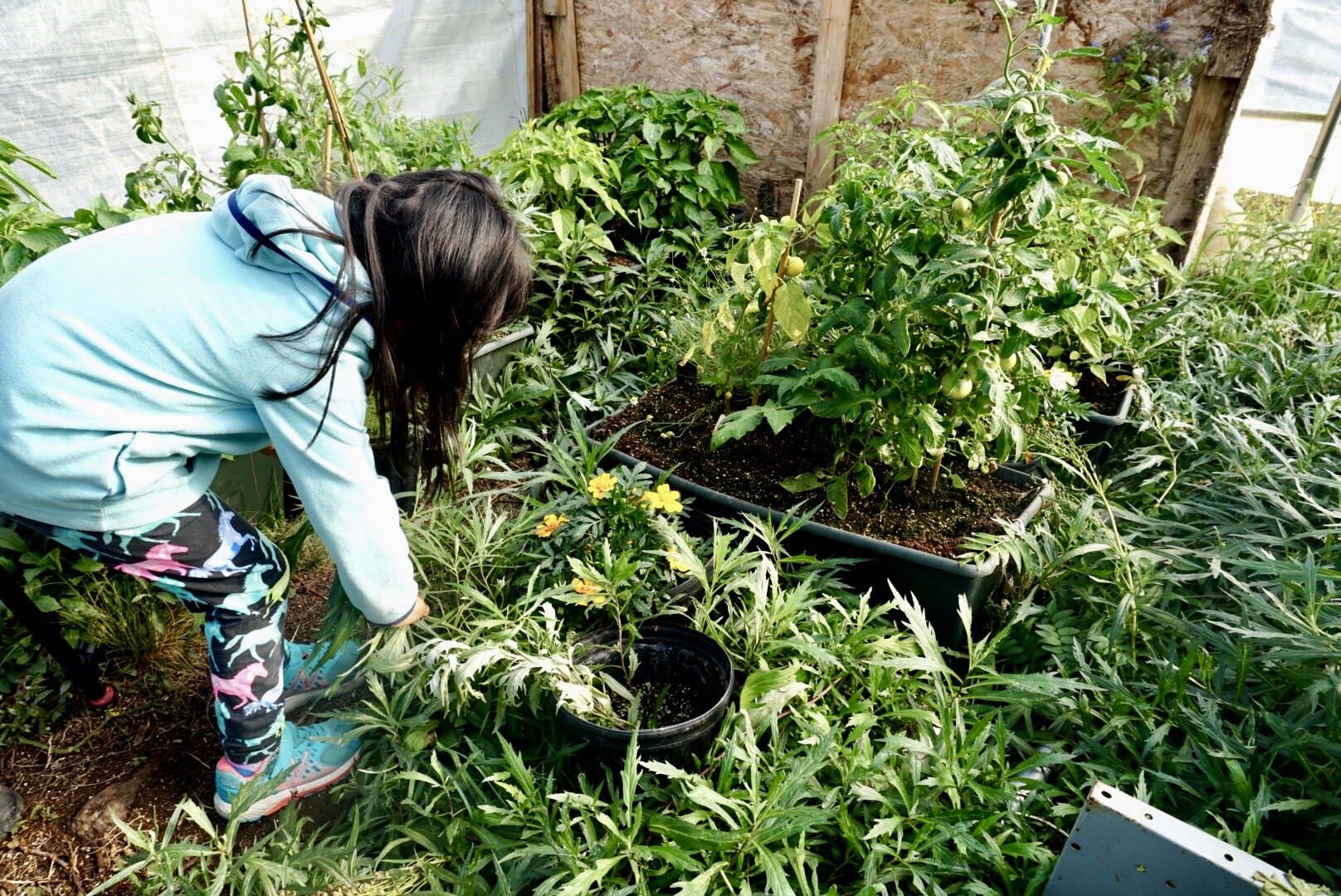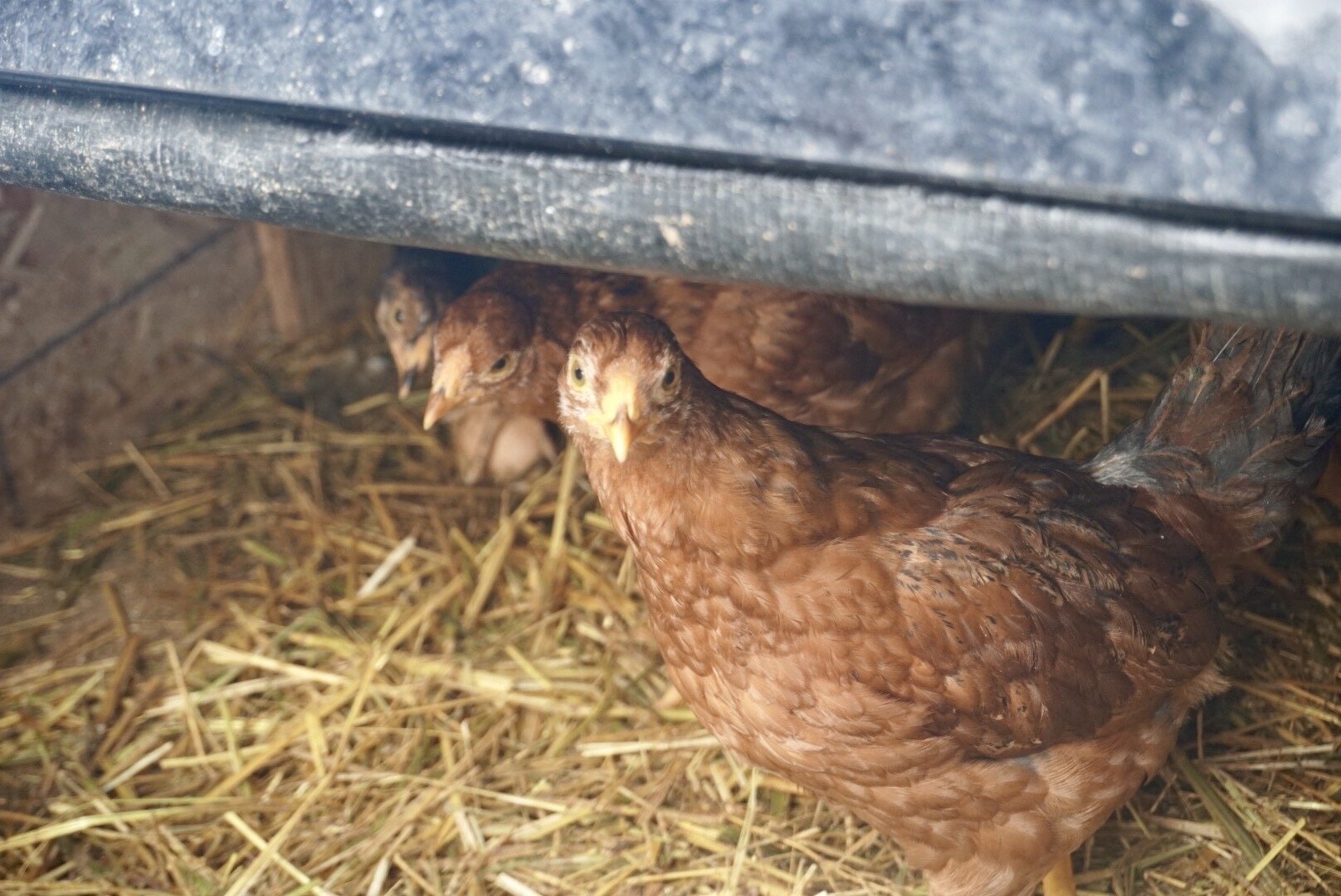After we visit with the chickens, we head inside Rainey’s house and with coffee in hand, sit down to chat.
Here’s an edited version of our conversation:
EM: Do you consider yourself a farmer?
NRH: No, I don’t know what to call myself. That’s why I kind of fumble. People are like, what do you do? And I’m like Inupiaq agriculture something. Because it’s not just agriculture. It’s culture, culture. It’s like a mesh between our culture and agriculture.
EM: It’s like a new model that doesn’t necessarily fit the traditional vocabulary of farming?
NRH: Yeah, because when we think of farming, we think of red barns and chickens and cows and straw hats and overalls, and that’s not what it’s gonna look like up here at all. And it’s predominantly a male industry and up here, we’re finding that it’s mostly women that get into it.
EM: I’ve noticed that. Why do you think that is?
NRH: The men are the ones that usually go out and are gone for days. Depending on the season—duck season, sheep season, fur season, caribou season. They’re running around, literally running around. It's the women that tend to stay closer to home and have more time and ability to care for baby plants.
EM: What are some ways that you would say the model of agriculture that’s going to work here differs from that more Western model?
NRH: In our culture and in communities, we tend to take the value first and then build around that value. I’m not focusing on making a lot of money. It’s not my goal to make tons of money and become a millionaire from growing strawberries. My goal is to provide a service for my community and to make my people better—health-wise, mentally, and just to give them an option that they didn't have before. And I guess I could just lean more toward making money and get super technical and plan everything out perfectly and only focus on like three crops. There’s ways to do it, but I think with this model it's more focused around realizing that 50 percent of my product is going to be given away to elders. That’s just what I do. And that’s just part of our culture first, it’s our values first and then the model kinda builds itself around it. I think that's the difference is our starting point
EM: What’s been the reaction in the community to your project?
NRH: At first it was a lot of confusion. It's not a “normal,” Inupiaq, Native thing to be gardening or to be involved in agriculture. In our tradition, we had 1000s of years of relationships with plants and feeding plants and caring for plants and walking to plants, you know, we had this connection and then we lost it when we stopped being nomadic. So that was the Initial reaction was just, that’s very weird, you’re growing alien vegetables. A lot of people here are not familiar with zucchini and kale and stuff like that because they don't ship them here. They don’t have a really long shelf life, so they’ve never been exposed to those kinds of vegetables. And then I started cooking things, and I’d give away a lot of free things, and it’s slowly catching on that it’s not odd and it’s becoming normal, not weird. So I’m really happy about that. That’s a goal of mine.
EM: Do you use food from the high tunnel in traditional dishes ever?
NRH: Yes, nonstop constantly. I like mixing it because it kinda puts a new spin on old stuff. Because people have this vision of old-timey, Inupiaq food of being not as tasty or survival food. That really irks me. And so it’s like this can be a modern thing too. I mean back in the day, the old-timey carrots weren’t sexy and cool until you do something cool with it like caramelize it. You can do all kinds of things with food. And I think that’s really important to bring that forward into now. I really encourage people to be like, okay, what does it mean to be Inupiaq now in this day and age. These are our values, but what does that mean now. What does that look like.
EM: Was there knowledge that you had learned from Inupiaq culture and from your relationship to plants there that you then transferred to growing things in the high tunnel?
NRH: I just realized that part of the beginning story of this whole thing was I actually was talking to somebody here. One of the original elders here, she used to bury potatoes along the creeks up north and then she’d come back in fall and dig ‘em up and get like 100s of pounds of potatoes. I thought that was fascinating because that was a long time ago and a very traditional native woman, and she was growing potatoes.
But that’s where it originated from. It’s just this mishmash of all this information. I work a lot with traditional plants, and I think of how can it be used parallel in agriculture. For example, stinkweed is a good insect repellent to keep aphids out of the high tunnel.
I talked with a woman, her mom at her cabin would would transplant stinkweed and medicinal plants to her cabin and then she would feed these plants. And what she would feed them is—they call it pudding—but it’s the partially digested contents of a caribou stomach. It’s green, it’s kind of smelly, vinegary, but it’s all broken down and available with enzymes. And she said she just stuck that into the ground and these plants that are normally two-feet tall would grow six-feet tall, seven-feet tall. And I was like, how can I use that in agriculture? There’s a perfect resource right there because we live off caribou, we don't eat the innards anymore. This stuff pops up all the time. But yeah, there’s a lot of parallels and a lot of things to be learned from both sides I think.
EM: You talked about your community’s relationship to plants and the history there and how it’s evolved over time—I wondered if you wouldn’t mind talking about that a little bit more. You had mentioned that nowadays people don’t think of the plant relationship, but historically it was there.
NRH: Yeah, I mean if you want to go back in history, I think it started with the generation that was taken when they were very young and shipped to residential schools. They have a memory of living off the land and of plants and vegetables, but there’s a huge gap in their knowledge, so when they came back, that knowledge pretty much was starting to fade away.
So traditionally, way, way back in the day, right around the time of us meeting Western culture, we relied more heavily on plants from the land and roots and berries than we do now. And there’s this perception of in our culture that we’re meat eaters. Literally, they call Eskimos, which I guess in the language means meat eaters. We kinda bought into it a little bit and forgot that there was this part of our culture that was centered around plants, not only for food or medicine, but just utility for everyday things.
We had this relationship with them that I thought was pretty interesting because people didn’t realize what it meant. We would pull the plants that we didn’t want that were competing for food, and we would leave behind fish skins and fish bones, or you would always make sure you left something behind. If you took a plant, you left something behind to replace that food you moved. And so, in a way, you could think of it as an early type of agriculture. And so getting back to that being okay and something that we actually talk about I think is really important.
EM: When you talk to the elders in the community, do they see what you’re doing as carrying on a tradition or are they kind of like, oh, but you’re growing lettuce, you’re not going and gathering traditional plants?
NRH: I think part of the boundaries that I’m trying to break through is this idea that we always have to be doing the same thing for 1000s of years and part of that is recognizing our own history. We used to eat mammoth. Our historians and our elders remember recipes--how to cook a mammoth, how to cut a mammoth, how to divvy up a mammoth, how to kill a mammoth. And it's still passed down, generation after generation, even though it's been something like 4,000 years since we actually hunted mammoth. I look at it as the people that hunted mammoth were Inupiaq but after the mammoth disappeared, they were still Inupiaq.
Our talent and our Inupiaqness, our nativeness, is tied to adaptability and being able to survive and even thrive in an environment because we are very adjustable, and we conquer whatever we're given.
EM: Do you think that a warming or a changing climate has impacted your growing abilities at all or?
NRH: Yes. Definitely, definitely, yes. And I know I haven’t been growing that long. But, there was kind of like a stableness in the first few years and then everything kind of just went haywire and to the extremes. Not only with plants and heat and heat stress and sunburn and all that kind of stuff, but also, insects, we’re getting fluctuations in insect populations. You know, when I first started this in my own backyard garden, I would go back there and some evenings it would literally be humming with just 1000s of insects. And that doesn't happen anymore, even outside, and in the high tunnel. We don’t nearly get as much pollinators as we used to. We get slugs and invasive species of slug.
Animals are behaving differently too. And plants move and are moving.
I keep my eye on plants coming from the south. We have cottonwood coming up, trees are actually up here now, and a lot of them don't survive, but there’s maybe a four-year-old cottonwood out here. Which indicates that the permafrost layer has receded enough where it can have a good root system. Everything’s kind of shifting and we’re kind of trying to shift along with it.
EM: You mentioned that access to healthy fruits and vegetables and things in your community is challenging. Why is that a challenge?
NRH: So, in the villages everything comes in on a plane. Sometimes your produce is going to be sitting at the airport for a very long time. So it has to be able to sit on shelf or box for a long period of time and so that limits you on what you could ship to a village. So they’re not appetizing, they’re not nutrient dense. They don’t pick things of how healthy it is. And it’s extremely expensive because they have to go on this monstrous journey and pay per pound in an airplane. So, I remember one winter I got really desperate and paid I think it was 12 dollars for like a one pound cabbage. It was insane. But I really wanted a cabbage. I was like, I need something green, and I love cabbages. So I paid it, but it was very painful to pay it. And sometimes it’s cheaper to buy a box of heat-and-eat chicken
EM: Do you see a future for agriculture in the arctic, in some capacity?
NRH: I do. I think it'll change. It might not look anything like I’m making it look right now, and I think that’s great. I think it should change and grow and morph into whatever is needed at the time. I'm not really determined to make it exactly how I think it should look ‘cause that’s, you know, that’s not how our culture rolls. That’s not our values. It’s more of just how is it serving the community. How is it serving our culture. By promoting greens and eating healthier, we are also promoting learning plants from the land at the same time and just making people get to know plants again.
You know, who knows what my daughter’s gonna do with all this. I’m kinda excited to see. She might really be into hydroponics which would be weird. But it might look completely different in 20 years. And that’s fine with me.
EM: Does she enjoy working with you?
NRH: Yeah, not only does she know more Western plants, but she knows traditional plants too, and she can identify them already, and she knows how to pick them and how to treat them and all the stuff that goes with traditional Native plants and she also knows how to treat and eat and prepare and wash carrots and kale and sugar snap peas.
EM: And how old is she?
NRH: She’s five years old (laughing). But she’s grown up… You know, I’m dragging her with me everywhere I go. Whatever I’m doing, she’s doing so.
EM: Do you have plans for the future of the Gardens in the Arctic project. Dreams, goals, hopes, next steps?
NRH: One of my goals is to have more of me. I want there to be like 30 of Rainey, weird Rainey agriculture people, all across the Slope, so it’s not just me. You know, I want it to be normal. I want people to have their favorite type of kale or even just with traditional foods. I want people to be more self-aware of what we're putting in our bodies. I think I’m aiming for healthier, healthier population, definitely. Dreams.











